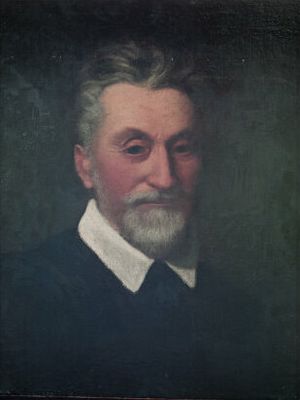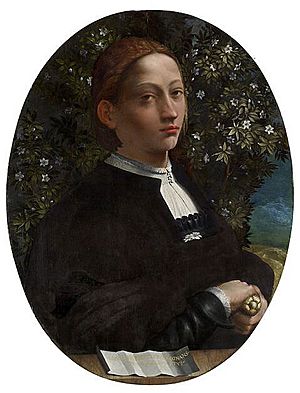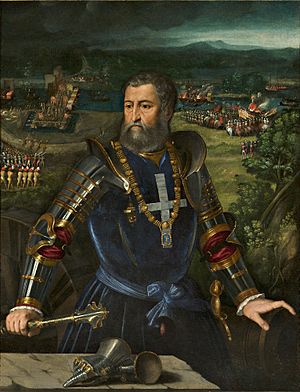Dosso Dossi facts for kids
Quick facts for kids
Dosso Dossi
|
|
|---|---|

Self-portrait
|
|
| Born | 1489 |
| Died | 1542 (aged 52–53) |
| Nationality | Italian |
| Education | Lorenzo Costa |
| Known for | Painting |
| Movement | Italian Renaissance |
| Patron(s) | Alfonso I d'Este, Duke of Ferrara, Ercole II d'Este, Duke of Ferrara |
Giovanni di Niccolò de Luteri, known as Dosso Dossi (born around 1489, died 1542), was a famous Italian Renaissance painter. He was part of the School of Ferrara. His painting style was greatly shaped by Venetian painting, especially by artists like Giorgione and early Titian.
From 1514 until he died, Dosso Dossi worked as the main artist for the Este Dukes of Ferrara and of Modena. Their small court was known for being a center of art. He often worked with his younger brother, Battista Dossi, who had learned from the famous artist Raphael. Dosso Dossi painted many scenes from myths and stories with hidden meanings. These paintings often had a dream-like feel and sometimes used colors in surprising ways. His portraits also showed people in unusual poses or with unique expressions for court paintings.
Contents
Life of Dosso Dossi
Dosso Dossi was born in San Giovanni del Dosso. This is a small village in the province of Mantua, Italy. We don't know much about his early life or how he learned to paint. His father came from Trento. He worked as a manager (called a bursar) for the Dukes of Ferrara.
Early Training and Career
Dosso Dossi might have learned to paint locally from Lorenzo Costa. He also might have trained in Mantua, where he was known to be in 1512. By 1514, he began working for the dukes Alfonso I and Ercole II d'Este. He served them for thirty years, becoming their main court artist.
Dosso often worked with his brother, Battista Dossi. Battista had learned his skills in Raphael's workshop in Rome. The art Dosso created for the dukes included temporary decorations for furniture. He also designed sets for plays. He is known to have worked with another artist named il Garofalo. They worked together on a large painting called the Costabili polyptych. One of his students was Giovanni Francesco Surchi.
Dosso Dossi's Unique Style
Dosso Dossi is not as famous for painting things exactly as they look. Instead, he is known for his mysterious story-paintings about myths. These were popular subjects for the art-loving court in Ferrara. Other artists like Cosimo Tura also decorated the Palazzo Schifanoia with similar themes.
Dossi sometimes made figures look a bit strange or out of proportion. This might seem like a cartoon or even a very old style of art. The art expert Sydney J. Freedberg thought this was part of a Renaissance idea called sprezzatura. This means "studied carelessness" or artistic calm. Dossi also used unusually bright colors in his smaller paintings. Some of his works, like the Deposition, have a glowing quality. This reminds some people of paintings by Correggio. Most of his paintings show Christian or Ancient Greek stories. He mainly used oil paints.
Famous Mythological Paintings
Dosso Dossi painted scenes from famous stories. One example is a painting based on the Aeneid. This scene shows Aeneas being led by the Cumaean Sibyl into the Elysian Fields. This is a beautiful place in the afterlife. You can see Orpheus playing his lyre in the forest. In the background, there are ghostly horses of dead warriors.
Another painting is Hercules and the Pygmies. In this story, Hercules falls asleep after beating Antaeus. Then, an army of tiny pygmies attacks him. Hercules defeats them and gathers them up in his lion skin. Paintings showing a strong Hercules were often made for Duke Ercole II d'Este. The Duke's name, Ercole, is the Italian name for Hercules. The meanings of paintings like Mythological Scene and Tubalcain are not fully known.

Recently, a painting called "Portrait of a Youth" at the National Gallery of Victoria was identified. The museum now believes it is a portrait of Lucrezia Borgia by Dosso Dossi. Before, it was thought to be an unknown young man by an unknown painter.
In Ferrara, some of Dosso Dossi's students included Gabriele Capellini, Jacopo Panicciati, and Giovanni Francesco Surchi.
Selected Works by Dosso Dossi

Here are some of Dosso Dossi's well-known paintings:
- Holy Family with Donors (1514, Philadelphia Museum of Art)
- Aeneas in the Elysian Fields (1518–1521, National Gallery of Canada, Ottawa)
- The Virgin Appearing to Sts John the Baptist and John the Evangelist (1520s, Uffizi Gallery, Florence)
- Jupiter painting Butterflies, Mercury and the Virtue (1524, Wawel Castle, Kraków)
- Mythological Scene (around 1524, J. Paul Getty Museum, Los Angeles)
- Allegory of Music (1530s, Museo Horne, Florence)
- Allegory of Fortune (around 1530, J. Paul Getty Museum, Los Angeles)
- Portrait of a Woman (1530–1535, Musée Condé)
- Virgin of the Assumption and St. Michael the Archangel (around 1533–34, Galleria nazionale di Parma)
- Three Ages of Man or Rustic Idyll (Metropolitan Museum of Art)
- Aeneas (Barber Institute, Birmingham)
- Hercules and the Pygmies (Alte Galerie of the Joanneum Graz)
- Tubalcain (Allegory of Music) (Museo Horne)
- Witchcraft (also called Stregoneria or Choice of Hercules between Vice and Virtue) (Galleria degli Uffizi)
- Saint Michael (Staatliche Kunstsammlungen, Dresden)
- Saint George and the Dragon (Staatliche Kunstsammlungen, Dresden)
- Portrait of a Warrior (Uffizi Gallery, Florence)
- Portrait of a Youth (portrait of Lucrezia Borgia, National Gallery of Victoria)
- The stoning of Saint Stephen (Thyssen-Bornemisza Museum, Madrid, on loan to the MNAC Barcelona)
See also
 In Spanish: Dosso Dossi para niños
In Spanish: Dosso Dossi para niños

